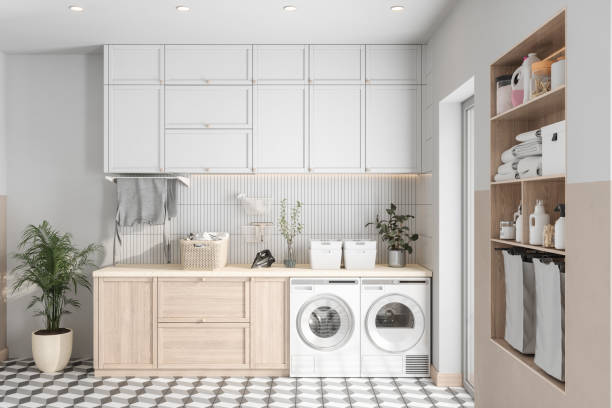Laundry Room Design Ideas
The main purpose of doing the laundry is to get your clothes and linens clean. If you are lucky enough to have a room dedicated to laundry, you know how convenient it can be to have everything within reach. Channel your resources into fitting your laundry room to make laundry management simpler. Here are tips to help you make your laundry room design to be efficient and functional.
• Washing machines: Buy only basic models with standard features. The main options you need on your washer include the size of your washing machine, its capacity, a water level selector, a temperature selector, a cycle selector, and energy efficiency.
Look for Energy Star horizontal-axis front loading washer or top-loading washers which tumble clothes instead of twisting or rubbing them. These models which don’t have agitators use less water and energy than top-loaders of the same size.
Internal water heaters reduce demand on your home water heater. The heater improves cleaning performance.
Wash tubs made from polypropylene and stainless-steel don’t chip or rust as enameled steel can.
Selectable spin speeds of 700 to 1600 revolutions per minute mean that clothes are almost dry when they leave the washer. Drying gets done in less time and at lower temperatures.
Most washing machines come in top-loading or front-loading models. If you have a limited space, a top-loader may be your only option. Most washers occupy less than 33 square inch of floor space. Generally washing machines measure from about 24 to 33 inches wide. For front-loading and unloading allow 36 inches in front of the washer. Front-loading machines use less water, but they are more expensive and hold smaller load than top-loading machine.
• Clothes dryer: Consider the energy costs to run your dryer as well as basic and special features. All you need are normal, delicate, and permanent-press timers. Standard temperature settings are hot, warm, and cool.
Choose a dryer with a moisture sensor that will automatically shuts off the machine when clothes are dry; this save energy and reduce the wear and tear on your clothes that caused by over drying.
Most dryers whether freestanding or stackable are 27 inches wide. Allow 42 inches of work space in front of the clothes dryer. Verify your dryer’s power source and voltage when planning your laundry room design.
When installing your dryer, use the straightest and shortest line possible for the venting duct. Straighter lines seldom clogged with lint, and that cut down on potential fire hazards. Look for easy-to-access lint filters that can be cleaned before or after each load.
Install your dryer on a one-foot-high sturdy platform made of high-density plastic or base made especially for your model of appliance so you won’t have to bend over as far when loading and unloading your laundry.
• Iron and ironing table:
A dry iron has a flat soleplate with a heat-generating electric element. The most common and versatile iron is a steam iron. Usually the more features your steam iron has, the easier your ironing task will be. Nonstick soleplate surface make cleaning starch build up easier; this has nothing to do with how smoothly the iron glides over fabrics. A clean stainless steel soleplate works just as smoothly. You will want to figure the best and most efficient way to store and use your iron and ironing board when planning your laundry room design.
Soleplate saver tips:
1. Do not iron over metal zippers, snaps, hooks, or pins.
2. Occasionally clean the soleplate from build up with mild soapy damp cloth and dry with a dry cloth.
3. Never use abrasive pad on the soleplate.
4. Always store your iron up right on the heel plate.
An ironing board with a convenient feature such as built-in version with a pull down or foldaway board may be good for your laundry area. This type can be easily hidden in a wall cabinet when not in use.
For free-standing ironing boards, look for adjustable models that are easy to fold for set up and storage and that allow comfortable use either when sitting or standing. Ideally, the ironing surface should be at hip level for ease of use. The additional features to look for are the cord holders that prevent tangles, the iron rests that prevent heat build up under the pad cover, and racks for hanging clothes.
Ironing board pads and covers should be made of thick cotton to reduce over heating from beneath and to reduce wrinkling. Pads with nonstick coatings are designed to make starch clean up easier.
• Folding table: If you have enough space in your laundry room, set up a small table on which you can fold your cloths after they come out of the dryer.
• A trash can: A trash can is important in the laundry for disposing lint, used dryer sheets, or empty detergent boxes. It can be a visual reminder for you to clean out the lint screen after each load.
A properly outfitted and well-planned laundry room makes doing your laundry easier. Create your laundry room design for maximum efficiency; this is no-ancient-Chinese secret.





